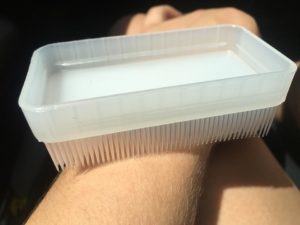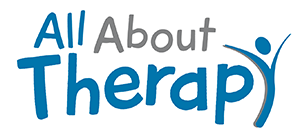Often after completing an Internet search for occupational therapy tools parents will ask me, what are those brushes for? Does my child need one? Those brushes are used for the Wilbarger Deep Pressure and Proprioceptive Technique (DPPT), formerly known as the Wilbarger Brushing Protocol. The program involves a series of brushing and joint compressions. Your child may benefit from DPPT if they have sensory processing difficulties, especially tactile defensiveness. The brushing is done followed by joint compressions every 2 hours for at least 2 weeks. After the initial two weeks, the occupational therapist may recommend decreasing the amount of times the protocol is preformed per day. Eventually, the protocol may just be performed on an as needed basis (i.e. when the child is showing signs of sensory disregulation).
Benefits of DPPT:
-Decrease in tactile defensiveness (increased tolerance in wearing clothes, being touched/held)
-Improved ability to transition between activities
-Improved attention
-Improved sensory regulation
-Improved body awareness
The Brushing:
A special brush is used horizontally with consistent, deep pressure (the bristles of the brush should bend). Brushing is usually preformed over bare skin. If the child is very sensitive the brush may be used vertically over clothes. Brush up and down the arms and legs three times. Scrub the palms of the hands and bottoms of the feet for about 5 seconds on each hand/foot. Brush up and down the back three times. Do not brush the face or stomach.
The Joint Compressions:
Joint compressions can be done manually or with movements the child performs. 10 repetitions of joint compressions to each joint in the body must be preformed after the brushing. The child can jump up and down followed by walking on their hands (“bear walks”) or doing push ups 10 times to perform the joint compressions with movements. Here is how to do the joint compressions manually. Each movement should be done 10 times.
-Fingers: quickly press each finger into the direction of the palm
-Hand to elbow: hold the child’s hand in a high five position and behind their elbow with their elbow bent. Quickly press the hand into the direction of the elbow.
-Elbow to shoulder/shoulders: Place one hand on the child’s shoulder and one hand on the bottom of their bent elbow. Quickly press the elbow into the direction of the shoulder.
-Legs: Have the child sit with their bottom against a wall. Hold the bottom of their foot with one hand and stabilize above their knee with the other hand. Quickly press the foot into the direction of the hip.
Always use the technique under the supervision of a trained occupational therapist. If you think your child may benefit from DPPT, ask your OT today!
